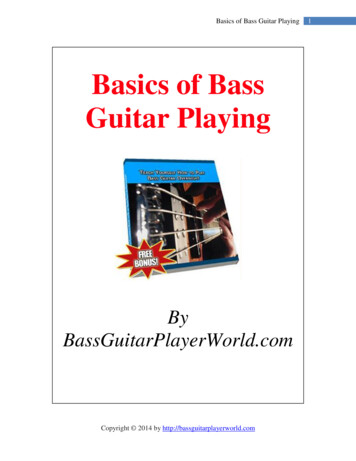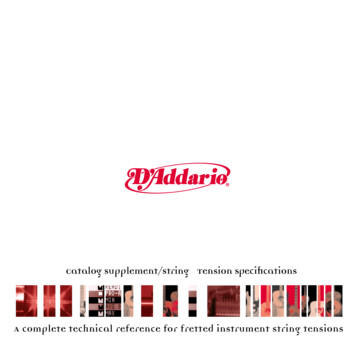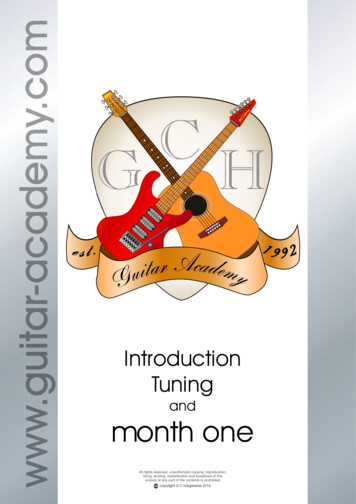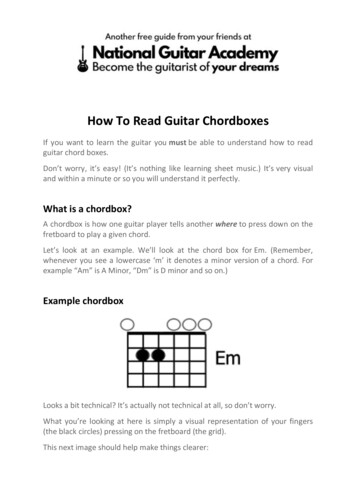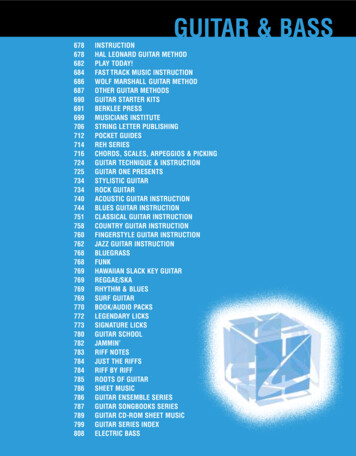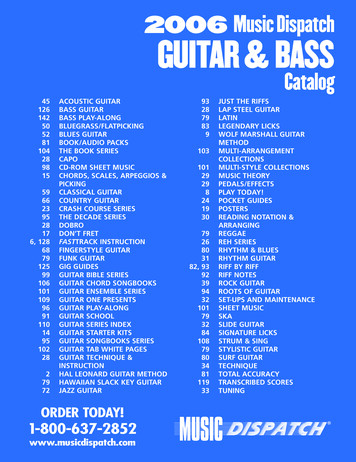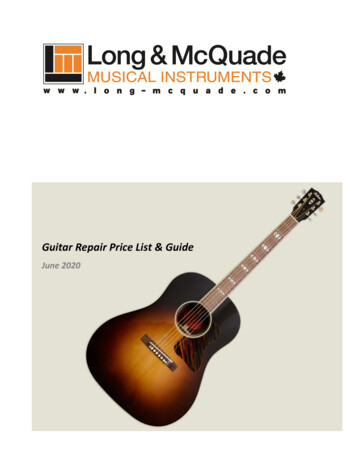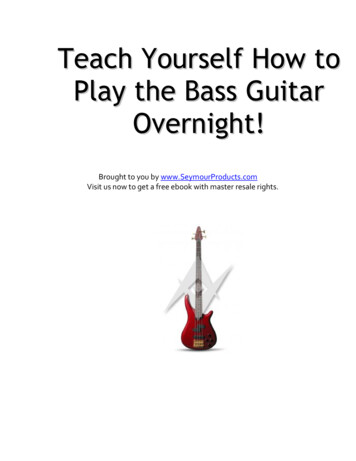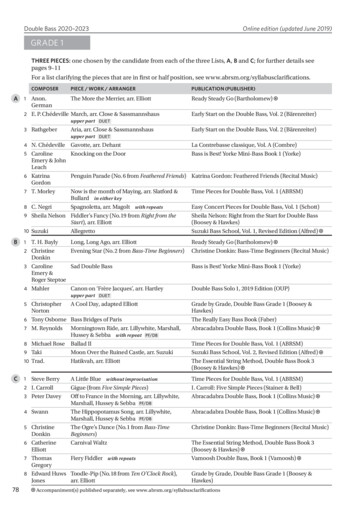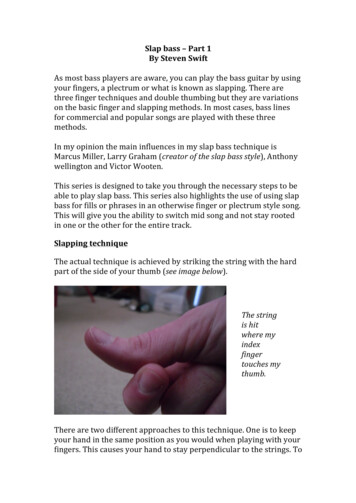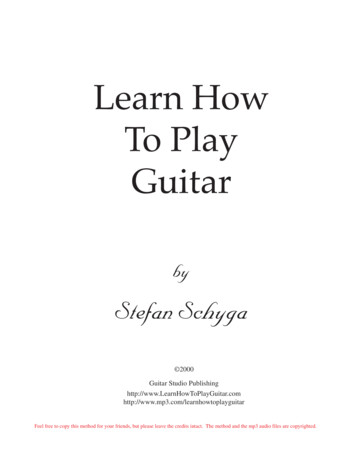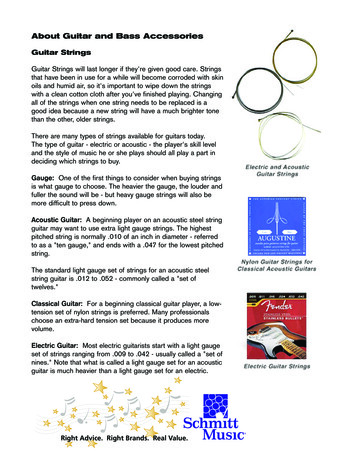
Transcription
About Guitar and Bass AccessoriesGuitar StringsGuitar Strings will last longer if they're given good care. Stringsthat have been in use for a while will become corroded with skinoils and humid air, so it's important to wipe down the stringswith a clean cotton cloth after you've finished playing. Changingall of the strings when one string needs to be replaced is agood idea because a new string will have a much brighter tonethan the other, older strings.There are many types of strings available for guitars today.The type of guitar - electric or acoustic - the player's skill leveland the style of music he or she plays should all play a part indeciding which strings to buy.Gauge: One of the first things to consider when buying stringsis what gauge to choose. The heavier the gauge, the louder andfuller the sound will be - but heavy gauge strings will also bemore difficult to press down.Acoustic Guitar: A beginning player on an acoustic steel stringguitar may want to use extra light gauge strings. The highestpitched string is normally .010 of an inch in diameter - referredto as a "ten gauge," and ends with a .047 for the lowest pitchedstring.The standard light gauge set of strings for an acoustic steelstring guitar is .012 to .052 - commonly called a "set oftwelves."Classical Guitar: For a beginning classical guitar player, a lowtension set of nylon strings is preferred. Many professionalschoose an extra-hard tension set because it produces morevolume.Electric Guitar: Most electric guitarists start with a light gaugeset of strings ranging from .009 to .042 - usually called a "set ofnines." Note that what is called a light gauge set for an acousticguitar is much heavier than a light gauge set for an electric.Right Advice. Right Brands. Real Value.
String WrapsThe three most common string wraps are Round Wound, FlatWound, and Silk and Steel.Round Wound: The most popular type of string wrap in theworld today, round wound strings are found on virtually everynew acoustic, electric, and bass guitar. They are designed witha round wire wrap over a round or hexagonal core. The soundis characterized by a bright tone with great sonic projectionand sustain.Flat Wound (or ribbon wound): Before the invention of roundwound strings, the flat wound string was the "king" of theguitar world. Instead of a round wrap over the core it uses aflat or ribbon-like wrap. This creates a very smooth playingsurface which is easy on the fingers. The trade-off, however,is that the tone is less bright and there is not as much sustain.These qualities make flat wound strings very popular with fastpicking jazz guitarists and walking bassists who want toproduce an "upright bass" tone.Silk and Steel: This string is great for steel string acousticprofessionals who want a lighter touch and a more subduedtone - without having to purchase a nylon string guitar. Thesteel core of the string is a wrapped with silk fibers coveredwith another wrap of silver-plated wire. This creates a stringwith less tension than traditional steel strings. These featuresmake silk and steel strings ideal for the beginner who ownsa folk guitar but has difficulty pressing down the steel strings.String Composition is the final consideration when selectinga string for your guitar.STRINGS FOR ACOUSTIC GUITARBronze is the most common acoustic "steel" string materialand creates a bright, focused, clear tone.Phosphor Bronze has a richer tone with slightly less brilliance- and tends to last longer due to the non-corrosive nature of theadded phosphor.80/20 Bronze creates the brightest tone of all "steel" stringsand provides great tonal projection.
STRINGS FOR CLASSICAL GUITARNylon strings come in a set with three unwrapped or monofilament treble strings and three wrapped bass strings made ofa multi-filament nylon core with silver-plated copper wirewrapped over it. They are traditionally tied to the guitar, althoughsome manufacturers make strings with "ball-ends" to facilitatestring changing. Nylon is the only type of string which should beused on a classical guitar as "steel" strings can damage theoverall structure of the guitar. (See section on nylon stringclassical guitars for more details.)STRINGS FOR ELECTRIC GUITAR & BASSNickel Plated Steel strings are by far the most popular forelectric guitars today. Steel is a highly magnetic material thatproduces a bright sound, and the nickel plating provides asmooth string surface.Stainless Steel strings provide the most power in volume andsustain due to their high magnetic qualities. Their stainless steelconstruction makes them resistant to humidity and skin oilsgiving them the longest playing life of any type of string.Pure Nickel strings are not as magnetic in quality as steel ornickel plated steel strings. Jazz guitarists often choose nickelstrings because they produce a "darker" sound.Other Guitar AccessoriesAcoustic Pick-up: A device used to amplify the sound of anacoustic guitar - usually placed in the sound-hole. It has astandard plug which is used to connect the guitar to theamplifier.Other types of pick-ups fit under the bridge section of the guitar.The two basic types are "thin-line" and "piezo." The thin-linetransmits the electrical signal by using the pressure of the stringto create the connection. The Piezo is made up of tiny crystalswhich transmit the vibration of the string to the amplifier. Both ofthese pick-ups usually require some drilling into the guitar itselfduring installation and are not recommended unless the guitar ismanufactured as an "Acoustic-Electric Guitar."Capos: Capos are used to transpose the notes played on aguitar allowing the guitarist to easily play in a variety of keys.Essentially a bar tied to the guitar neck, it holds down all of the
guitar strings at a chosen fret. For instance, in standard guitartuning the open strings are tuned to E-A-D-G-B-E. When a capois placed on the first fret, the sound of the strings is transposedup a step to play as F-Bb-Eb-Ab-C-F.Cases: An essential for anyone who wants to preserve thequality of his or her instrument. The three most popular types ofcases are Hard-shell, Gigbag, and Chipboard.Hard-shell cases are very durable and form fitted to a particularguitar shape. They are recommended for higher priced guitarsand solid topped acoustics. Many manufacturers will not honora guitar's warranty if it is not sold with a hardshell case.Gigbags are also form-fitted and heavily padded offering a greatdeal of protection from climactic changes. They also come witha shoulder strap and pouch designed for carrying music andaccessories.Chipboard cases are the least expensive style of case. They arenot form-fitted and do not provide as much protection fromclimactic changes or damage to the instrument from bumping ordropping it. Chipboard cases are usually recommended for lessexpensive laminated top guitars.Dampits and Humidifiers: Because solid top instruments aresusceptible to climactic changes, humidifiers have beendesigned to maintain the guitar in the accepted 35-55% rangewhen stored in their hardshell case or gigbag during the drywinter months.Electronic Tuners: Tuners provide a way of tuning a guitar tothe desired pitch. Two of the most common types are the GuitarTuner and the Chromatic Tuner.A Guitar Tuner is useful for beginners because it only allows theplayer to tune a guitar to the six standard notes - E-A-D-G-B-E.The Chromatic Tuner is more versatile because it can be usedto tune any instrument. It is generally used by more advancedplayers and can be used for alternate (non-standard) tunings.Guitar Stands: Although not recommended as a storagemethod, guitar stands provide a safe, convenient place to placea guitar during a gig or during practice without fear of it fallingover and becoming damaged.
Instrument Cables: Cables are used to connect an electricinstrument to its amplifier. They come in a variety of lengths witha standard plug on both ends. The cable is shielded to preventunwanted electrical disturbances from interfering with theinstrument's signal. Because the shielding causes electricalresistance (measured in Ohms), instrument cables cannot beused as speaker cables (cables that connect an amplifier to aspeaker cabinet).Instrument cables come in a variety of lengths from 6" to 25'.Guitarists use 6" to 1' cables for effects, 3' to 6' for practiceand recording sessions, and 10' to 25' for use on a stage. Ingeneral, the longer the cable the more likely that outsideinterference will be picked up over its length.Peg Winder: The peg winder is a useful tool to have when youneed to restring a guitar. It allows you to quickly wind the excessstring onto the guitar peg.Picks: Also called plectrums, picks are used by guitarists tostrike the strings (strumming the strings) instead of playing theguitar with thumb and fingers (finger picking). Normally made ofplastic or nylon, picks provide a harder surface to use whenstriking the string - creating a louder tone.Pitch Pipes: Like electronic tuners, pitch pipes come in bothguitar and chromatic styles. The user blows into the pipe, thentunes the string to match the pipe's pitch.Slides: Slides are used to create a unique guitar sound oftenheard in Blues, Country and Hawaiian playing styles. Slides areplaced on the player's ring finger above the second knuckle andheld down over the strings (but not held down too hard) so thatthe player can enjoy the sliding effect of a fretless instrumentand create the distinctive "slide guitar" sound. Slides come in alllengths, shapes, and sizes and are normally made brass orglass.Tuning forks: Tuning forks are the most basic form of tuningaide. The user strikes the edge of the tuning fork against thepalm of the hand or knee - but never against a hard surface likea table, as it can permanently affect the accuracy of the tuningfork. The user matches the pitch of the fork to a particular stringon the guitar and tunes that string to pitch. Using the tunedstring as a reference point, the remaining strings on the guitarcan then be tuned. The two most common tuning fork pitchesare E and A-440, a standard concert pitch. (Technically it is an"A" that vibrates at the frequency of 440 hertz, the same pitchas the A above middle C on a piano.)
Learning To Play: No matter what your age, interest or skilllevel, Schmitt Music has instruction books and method books,chord and scale charts, popular guitar sheet music and books,instructional video tapes, play-along CDs and computersoftware to help make your guitar playing more fun!Schmitt Music offers private one-on-one lessons forbeginners through highly advanced, as well as group orclass lessons for all ages and abilities.Check out the PRINT & MEDIA and LESSONS sections ofwww.schmittmusic.com for How-To-Play books, CDs andDVDs as well as information on guitar lessons – or visit theSchmitt Music store nearest you!
Schmitt Music offers private one-on-one lessons for beginners through highly advanced, as well as group or class lessons for all ages and abilities. Check out the PRINT & MEDIA and LESSONS sections of www.schmittmusic.com for How-To-Play books, CDs and DVDs as well as information on guitar lessons - or visit the Schmitt Music store nearest you!
